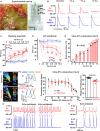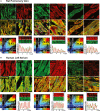Caveolae-Mediated Activation of Mechanosensitive Chloride Channels in Pulmonary Veins Triggers Atrial Arrhythmogenesis
- PMID: 31597508
- PMCID: PMC6818041
- DOI: 10.1161/JAHA.119.012748
Caveolae-Mediated Activation of Mechanosensitive Chloride Channels in Pulmonary Veins Triggers Atrial Arrhythmogenesis
Abstract
Background Atrial fibrillation often occurs in the setting of hypertension and associated atrial dilation with pathologically increased cardiomyocyte stretch. In the setting of atrial dilation, mechanoelectric feedback has been linked to the development of ectopic beats that trigger paroxysmal atrial fibrillation mainly originating from pulmonary veins (PVs). However, the precise mechanisms remain poorly understood. Methods and Results We identify mechanosensitive, swelling-activated chloride ion channels (ICl,swell) as a crucial component of the caveolar mechanosensitive complex in rat and human cardiomyocytes. In vitro optical mapping of rat PV, single rat PV, and human cardiomyocyte patch clamp studies showed that stretch-induced activation of ICl,swell leads to membrane depolarization and decreased action potential amplitude, which trigger conduction discontinuities and both ectopic and reentrant activities within the PV. Reverse transcription quantitative polymerase chain reaction, immunofluorescence, and coimmunoprecipitation studies showed that ICl,swell likely consists of at least 2 components produced by mechanosensitive ClC-3 (chloride channel-3) and SWELL1 (also known as LRRC8A [leucine rich repeat containing protein 8A]) chloride channels, which form a macromolecular complex with caveolar scaffolding protein Cav3 (caveolin 3). Downregulation of Cav3 protein expression and disruption of caveolae structures during chronic hypertension in spontaneously hypertensive rats facilitates activation of ICl,swell and increases PV sensitivity to stretch 10- to 50-fold, promoting the development of atrial fibrillation. Conclusions Our findings identify caveolae-mediated activation of mechanosensitive ICl,swell as a critical cause of PV ectopic beats that can initiate atrial arrhythmias including atrial fibrillation. This mechanism is exacerbated in the setting of chronically elevated blood pressures.
Keywords: arrhythmia; caveolae; caveolin 3; hypertension; mechanoelectrical transduction; pulmonary veins; stretch; volume‐activated chloride channels.
Figures








References
-
- Schotten U, Verheule S, Kirchhof P, Goette A. Pathophysiological mechanisms of atrial fibrillation: a translational appraisal. Physiol Rev. 2011;91:265–325. - PubMed
-
- Benjamin EJ, Levy D, Vaziri SM, D'Agostino RB, Belanger AJ, Wolf PA. Independent risk factors for atrial fibrillation in a population‐based cohort. The Framingham Heart Study. JAMA. 1994;271:840–844. - PubMed
-
- Haissaguerre M, Jais P, Shah DC, Takahashi A, Hocini M, Quiniou G, Garrigue S, Le Mouroux A, Le Metayer P, Clementy J. Spontaneous initiation of atrial fibrillation by ectopic beats originating in the pulmonary veins. N Engl J Med. 1998;339:659–666. - PubMed
-
- Tabatabaei N, Asirvatham SJ. Supravalvular arrhythmia: identifying and ablating the substrate. Circ Arrhythm Electrophysiol. 2009;2:316–326. - PubMed
-
- Sadek MM, Maeda S, Chik W, Santangeli P, Zado ES, Schaller RD, Supple GE, Frankel DS, Hutchinson MD, Garcia FC, Riley MP, Lin D, Dixit S, Callans DJ, Marchlinski FE. Recurrent atrial arrhythmias in the setting of chronic pulmonary vein isolation. Heart Rhythm. 2016;13:2174–2180. - PubMed
Publication types
MeSH terms
Substances
Grants and funding
LinkOut - more resources
Full Text Sources
Medical
Research Materials

